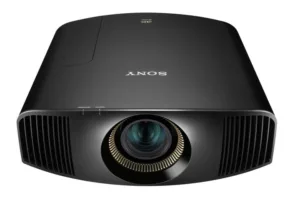Sony used a ballroom at CEDIA 2016 to make a side by side comparison of Sony projectors vs. two 4K competitors. The purpose was primarily to illustrate the differences between a native 4K projector (Sony) and shifted projectors that create “4K like” image from 1080p panels (JVC and Epson). While some specific test patterns do clearly show these differences, when watching ordinary video, it was far less obvious that there was a lot of loss in detail in the shifted projectors.
Sony primarily showcased their new VW675ES projector (see Sony Adds VW675ES 4K HDR Home Theater Projector at CEDIA) benchmarked against the JVC X950 and the Epson 5040. The 5040 is functionally identical to the new 6040 projector launched at CEDIA.
- JVC X950 – 1900 lumens, lamp based, $9,995 ESP, 4K resolution with pixel shift, 150,000:1 native contrast ratio
- Epson 5040 – 2500 lumens, lamp based, $2,999 ESP, 4K resolution with pixel shift
- Sony VW675ES – 1800 lumens, lamp based, $15K MSRP, native 4K resolution
In the photo below, the Sony projectors are on the right and the competitors on the left.
Luminance from these three projectors was surprisingly well matched and when set to the proper reference modes, the colors looked quite close as well. The projectors were not calibrated, but were set up “out of box.”
Content was from Sony’s new 4K Blu-ray player and other sources and consisted of clips from movies in 1080p, 4K and 4K HDR. The JVC and Epson projectors performed very well in this shoot out, I have to say. There was some very slight softness noticeable and some tiny details that could be pointed out, but you had to be close to the screen and look for them. Yes, experts will see them, but 99% of viewers will find the images nearly identical with one no better than the other, in my opinion.
In the photo below, the Sony image is on the left with the Epson (I think) on the right. One some images, the Epson’s skin tone was not right as could be seen visibly and as confirmed by Kevin Miller, who calibrates projectors for Epson, but had not done so in the Sony shoot out. He was at a loss to explain why.
Sony even showed one of its 1080p projectors with the Reality Creation engine turned on next to the JVC and Epson projectors. This compared very well making the case that maybe native 4K is not needed – especially if viewed from more than 7-8 feet (2M – 2.5M) away, which most home theater projectors are.
Sony then showed two test patterns. The first consisted of line pairs (horizontal, vertical and diagonal) plus checkerboard patterns. These were shown at 1 pixel, 2 pixel and 4 pixel widths. For the single pixel patterns, the Sony native 4K projector was able to properly display the patterns while the JVC and Epson projectors struggled. But the playing field was nearly level at the 2-pixel wide patterns. There was also a circle around these patterns. The JVC projector struggled with some segments of the circle missing, but the Epson fared better.
The second pattern was a composite image created from two photos. We believe this was created by doing a checkerboard single pixel sample of each image and merging them into a single image (one picture to the even squares and the other picture to the odd squares). The Sony and Epson projectors displayed this quite well, but the JVC projector displayed only one image. This demonstrated that JVC and Epson are using very different image shifting techniques.
Sony was clearly happy these test patterns showed the difference – and they are offering them to their dealers to help convince customers buy the Sony product. But I am not sure the video comparison would convince anyone to buy the Sony product, especially since it was the most expensive one in the comparison. – CC

